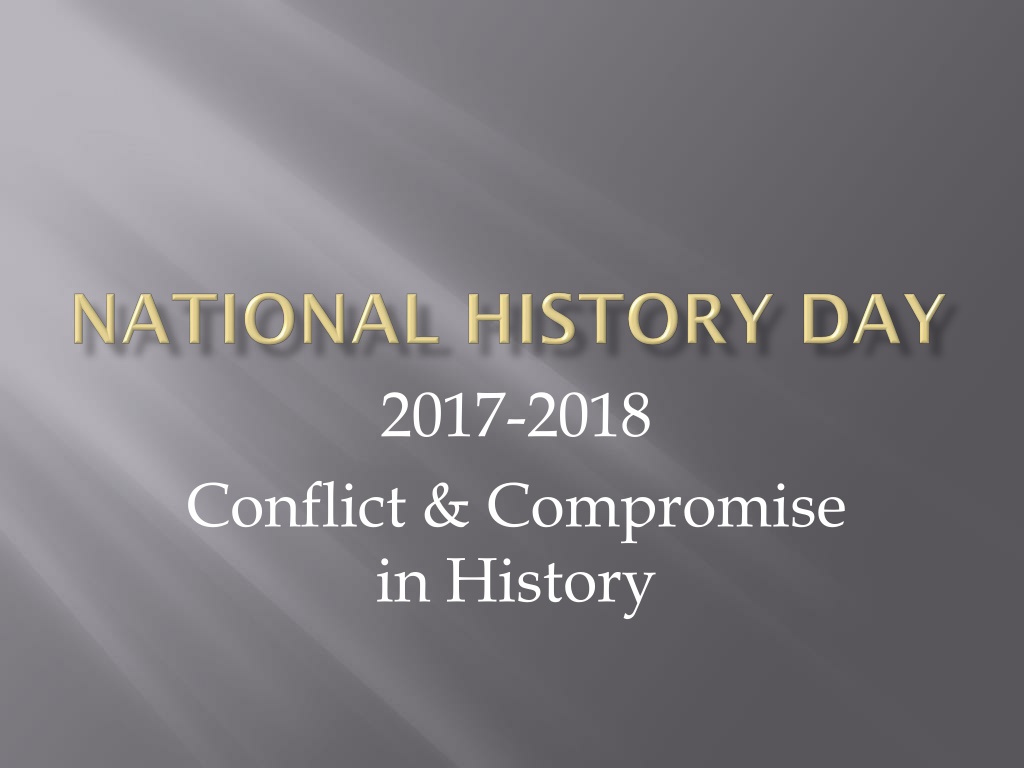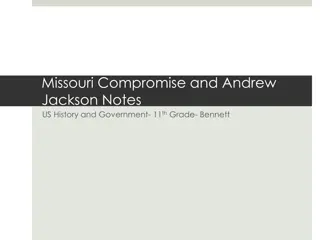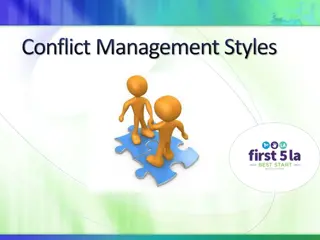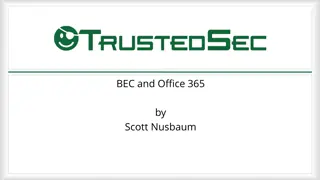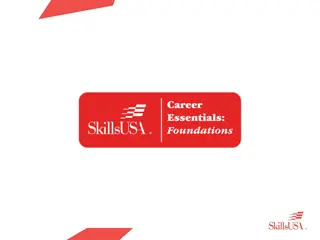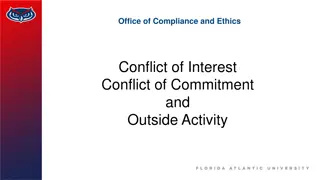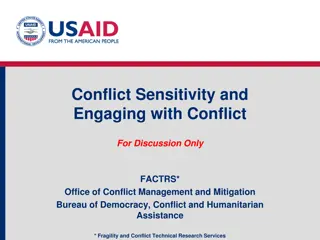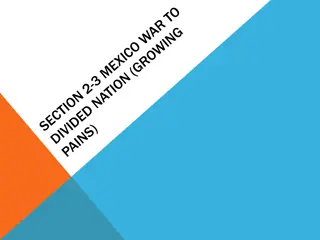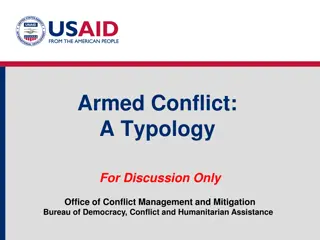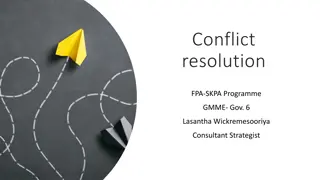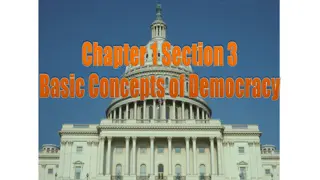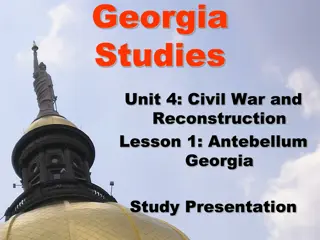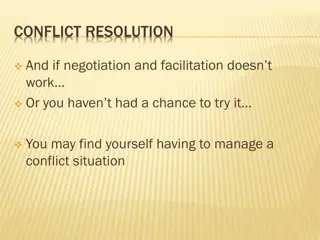Exploring Conflict and Compromise in History Through National History Day 2018
National History Day 2018 focuses on the theme of Conflict & Compromise in History, encouraging students to delve into topics such as failed compromises leading to revolutions, the Vietnam Generation, and conflicts like the Troubles in Ireland. Through research, students will explore historical contexts, impacts, and perspectives, studying significant events such as Galileo's clash with Catholicism and the Munich Agreement. The theme challenges students to understand how compromise can prevent or escalate conflicts, shaping the course of history.
Uploaded on Sep 17, 2024 | 0 Views
Download Presentation

Please find below an Image/Link to download the presentation.
The content on the website is provided AS IS for your information and personal use only. It may not be sold, licensed, or shared on other websites without obtaining consent from the author. Download presentation by click this link. If you encounter any issues during the download, it is possible that the publisher has removed the file from their server.
E N D
Presentation Transcript
2017-2018 Conflict & Compromise in History
2018 NHD Theme Conflict & Compromise in History To take a stand, one must take a firm position on an issue. Historically, National History Day (NHD) students will spend the 2017 2018 school year delving into a topic based on the theme Conflict & Compromise in History. Each year National History Day uses a theme to provide a lens to study history. The theme is always broad enough so that you can select topics from any place (local, national, or world history) and any time period. Once you choose your topic, you investigate historical context, historical significance, and the topic s relationship to the theme by conducting research in libraries, archives, and museums; through oral history interviews; and by visiting historic sites. This year s theme, Conflict & Compromise in History, requires you to view history through multiple perspectives. Compromise can sometimes prevent a conflict, but what happens when it does not? If a conflict occurs, how can compromise help to end the conflict? What happens if a failed compromise leads to an even larger conflict? Throughout this academic year, you will need to ask yourself these questions and more. (*Read your 2018 NHD Themebook)
2018 NHD Theme Conflict & Compromise in History No Taxation Without Representation: The Failed Compromise That Led to a Revolution Preventing Conflict: The Compromise of 1850 Conflicting Opinions, Compromised Values: The Vietnam Generation The Troubles: The Conflict and Compromise of Ireland
2018 NHD Theme Conflict & Compromise in History Galileo: The Conflict and Compromise Between Science and Catholicism The Munich Agreement: Appeasing Conflict The Six Day War
2018 NHD Theme Conflict & Compromise in History Historical Context & Impact are crucial! What s going on: Before, During & After your topic? What was happening before that led to your Conflict & Compromise in History topic? Why did your topic occur at the time and place it did? What was the significance of your topic? Why is it important historically? How has/will your topic altered various aspects of society? How has/does it affect us, society, our country & the world today?
Slavery ends after the Civil War and whites pass segregation laws, starting the Jim Crow era & civil rights conflicts Martin Luther King Jr. is called to lead a bus boycott in Montgomery Rosa Parks Refuses to Give up Her Seat & is Arrested So many African Americans boycott, the bus company has to compromise & change its policy The boycott sparks the Civil Rights Movement Montgomery AL had a law requiring segregation on busses Rosa Parks finally has enough
Topics should be historically significant Topics should be at least 20 years old (1997 & before) or Hurricane Katrina Sorry, you can t do September 11
Your entry must include the following written material in the order presented below: 1. a title page 2. a process paper 3. an annotated bibliography
A title page is required as the first page of written material in every category. Your title page must include only the title of your entry, your name(s), and the contest division and category in which you are entered. NOTE: The title page must not include any other information (pictures, graphics, borders, school name, or grade) except for that described in this rule.
All categories except historical paper must include a process paper with the entry. It must describe in 500 words or less how you conducted your research and created your entry. The process paper must include four sections that explain: 1. how you chose your topic; 2. how you conducted your research; 3. how you selected your presentation category and created your project; and 4. how your project relates to the NHD theme. You can view sample process papers at www.nhd.org on the Creating an Entry page in the Contest section.
An annotated bibliography is required for all categories. List the sources that contributed to the development of your entry, sources that provided usable information or new perspectives in preparing your entry. You likely will include fewer sources than you actually used. Sources of visual materials and oral interviews must be included. The annotations for each source must explain how you used the source and how it helped you understand your topic. For example: Bates, Daisy. The Long Shadow of Little Rock. New York: David McKay Co. Inc., 1962. Daisy Bates was the president of the Arkansas NAACP and the one who met and listened to the students each day. This firsthand account was very important to my paper because it made me more aware of the feelings of the people involved.
There are four categories to choose from: Documentary Exhibit Performance Website 1. 2. 3. 4.
Make your own documentary. Things to think about: Am I interested in using computers, cameras, and other technologies? Can I conduct and record interviews (for the purpose of including film clips in the documentary)? Can I find film clips to use in my documentary? Are there enough still photographs related to my topic and that I can use in my documentary? Do I have access to equipment that will be needed to make a documentary? Is creating a documentary the best way to show off my topic?
The exhibit category is three dimensional and is displayed on a physical structure. Exhibits use color, images, documents, objects, graphics, and design, as well as words, to tell your story. Exhibits can be interactive experiences by asking viewers to play music, solve a puzzle, look at a video, or open a door or window to see more documents or photos.
The performance category is the only one that is presented live. Developing a strong narrative that allows your subject to unfold in a dramatic and visually interesting way is important. Memorizing, rehearsing, and refining your script is essential, so you should schedule time for this in addition to research, writing, costuming and prop gathering.
Create your own website about your topic. You must use the NHD web generator for it to be a valid entry. You need access to the internet and a computer.
Do not work with friends Local issues and history are more likely to move on. You cannot work with a student whom is not in your period. Meet the bench mark deadlines. No groups over three people. You must have your topic selected by Oct. 6 (*It cannot be changed.)
